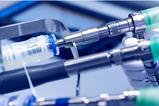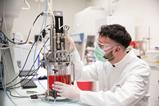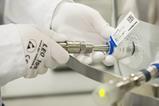Automated, real-time control of dissolved CO2 has been an elusive feature in biopharma. Now Hamilton promises to simplify in-line measurement of dCO2 with its new solid-state ‘CO2NTROL’-sensor. Hamilton integrated several key features into a bioprocess-compliant 12 mm sensor.
Measuring critical process parameters is key in optimizing bioreactor performance. “Accurate, real-time measurements of pH and dissolved O2 have been possible for many years, but dissolved CO2 measurement always had its drawbacks”, says Giovanni Campolongo, Market Segment Manager at Hamilton Process Analytics. “Yet, importantly, even minimal variations in dCO2 can have a significant impact on cell culture productivity.”

Maintenance-free
To control dissolved CO2, a tool to measure it is a pre-requisite. Measuring dCO2 involves an intricate trade-off between three key factors: reliability, cost, and real-time control. Current technologies try to strike a balance, but never achieve the optimal overlap. “Off-line control is reliable, but expensive”, says Campolongo. “The currently available sensors for real-time in-line measurements based on the Severinghaus principle are not always accepted as reliable, and not cost-effective at all.”
“Even minimal variations in dCO2 can have a significant impact on cell culture productivity”
Sensors that use the Severinghaus indirect electrochemical technology are in fact modified pH sensors, which are fragile and prone to electrolyte fouling. They have to be re-calibrated and monitored often before, during and after use. “It was clear to us that we needed to develop a solution that overcomes these major drawbacks”, says Campolongo. With the new sensor ‘CO2NTROL’, Hamilton seems to have achieved this milestone. “CO2NTROL is a solid-state optical sensor”, explains Campolongo. “It is therefore maintenance-free, can be simply calibrated, and has the highest accuracy in the bioprocesses application range. There is no need to replace any consumable part, even after several autoclavation or SIP/CIP processes.”
Peace of mind
CO2NTROL works with middle-infrared wavelengths that interact specifically with CO2 molecules. These absorb only one wavelength, and so the amount of radiation that reaches the middle-infrared range detector correlates directly with the CO2 concentration in the sample. “The principle is known in spectroscopy theory”, emphasizes Campolongo. “Our innovation is that we integrated all of this into a bioprocess-compliant 12 mm sensor.”
In short, CO2NTROL is a robust opto-electronic process sensor without replaceable parts, developed for biopharma applications. In addition, this sensor doesn’t need an external transmitter – thanks to Hamilton’s digital Arc technology, it can be connected directly to digital control systems – and in combination with ArcAir software is ready for GMP compliance. Market introduction will be in May 2021. “The overall costs are five times lower than for Severinghaus”, notes Campolongo, “and the device is even more accurate. That’s the reason why customers are waiting for this solution. We call it a ‘peace-of-mind’ sensor.”



















